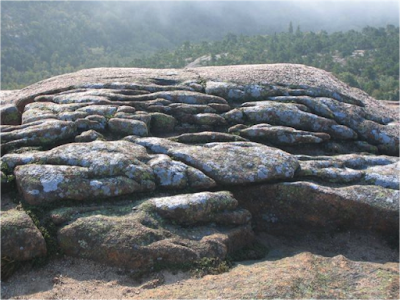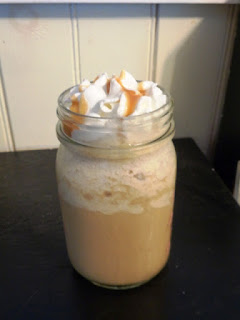Cold Brew
I recently discovered cold brew iced coffee. So, it seems has everyone else.
But why pay $4 for a cup of it from your local fancy coffee shop? It’s so stinkin’ easy to make at home. Just take 1 cup of ground coffee of your choice, add 4 cups of filtered water, stir it well, and let it sit for 12-24 hours at room temperature. Filter out the grounds, and there you go. However, it’s pretty strong. I usually dilute mine 50/50 with whatever strikes my fancy that morning. Milk, cream, water, ice, whatever. Today, I used one cup cold brew concentrate, ¼ cup cream, 6 ice cubes, and a generous squirt of caramel syrup, and blended.
Here’s how cold brew* works:
Coffee in general is what chemists refer to as a mixture. A mixture is a combination of two or more substances that each stay the same substance when combined. Salt water is a classic example. It’s still table salt (NaCl) and still water (H2O), but they are combined. This kind of combination of chemicals is called a physical change. (Yes, salt and water are chemicals - anything made of atoms is considered a chemical by the chemistry definition. Actually, the term “salt” refers to not just one chemical, but a whole category of chemicals. But that’s not super important for this example, so we’ll leave that for another time.) The salt is still salt, a chemical made by the ionic bond between the elements sodium and chlorine, in the ratio of one sodium atom to one chlorine atom. However, the salt has changed form - from a solid white cube to collection of dissolved ions. But clearly it is still salt. The dissolved salt tastes the same as the solid salt.
Salt water is a solution - a specific kind of mixture made when one substance dissolves into another substance so that the two are indistinguishable. Collecting a dropper full of salt water from the top of the mixture results in the same concentration of salt to water as a dropper full from the bottom (assuming you put in the correct ratio of solute - the salt - to solvent - the water - more on that later). Another term for this type of mixture is a homogeneous mixture, from the root word homo, meaning same. (The opposite is a heterogenous mixture, in which you can see all the individual parts, and each sample from the mixture is a bit different. Fruit salad is a great example of this kind of mixture. So is granite.)
 |
| Granite formation in Acadia National Park, Maine (c) lsimonds 2006 |
Try this at home - get cubes of something that dissolves in water, such as a sugar cubes, bouillon cubes, or those little colored pellets used for dyeing Easter eggs. Set up several cups of water. Make one cup hot. Make another cold. Put twice as many cubes in a cup. Stir a cup. Leave one cup overnight. What other possibilities can you come up with?
The rate of dissolving depends on how much of the solute (the cubes of some solid) are contacting the water at any given point. It makes sense that in order for water to dissolve a solid, the water molecules needs to touch the solid. This idea of change happening at interfaces - the point at which two different types of matter meet - governs many scientific observations, from the most basic chemical and physical changes to global surface processes such as weathering of rocks or melting of glaciers. (One form of this idea is called Collision Theory - the idea that two chemicals can only react if they bump into each other.) Another simple experiment - take loose sugar and a sugar cube of equal mass and see how long it take for each to dissolve in water of constant temperature and volume. The sugar cube takes longer, of course, even if you stir it, because only the outside of the cube interfaces with the water. The inner sugar crystals can’t dissolve until they are exposed to the water, which takes time.
When substances are heated, the atoms that make up that substance move quicker. In fact temperature in the purest scientific sense of the word is a measure of how fast the particles that make up a substance are moving. So since hot water molecules move around faster than cool water molecules, they come in contact with your sugar cube more quickly and more often than cold water ones. Therefore, your sugar dissolves faster. This is also why there is more undissolved sugar sludge at the bottom of your iced coffee than hot coffee - it’s not the fault of the barista failing to stir it properly, really. It’s because only so much solute can dissolve into a particular solution without help.
So back to coffee brewing.
Some of the chemicals in the coffee beans (of which there are many - flavonoids, antioxidants, caffeine, etc.) easily dissolve in water because they contain some degree of polarity - the extent to which one or more of the atoms in a molecule hogs the electrons. Water itself is a polar molecule. It is made of 2 hydrogen atoms bonded to one oxygen atom. They bond covalently, that is, the atoms share their electrons. But oxygen is like the big brother who is forced to share his X-box with his annoying little twin siblings. He shares a little, only when mom or dad is watching. The rest of the time he pushes them out of the way and doesn’t give them a turn. Oxygen is like that. Most of the time, the shared electrons spend time with the bigger, stronger oxygen atom. Since electrons are negative, the oxygen side of the water molecule is more negative, and the two hydrogens, positioned like Mickey Mouse ears on the oxygen atom, are more positive. Having a positive end and a negative end makes the whole molecule polar, like a magnet, and it can thus magnetically attract other compounds and molecules that have negative and positive ends, such as salt, sugar, and caffeine, causing them to dissolve.
Hot water brewing, usually with a drip coffee maker, happens relatively quickly, because of the bouncing around of the molecules. But some molecules dissolve easier in hot water than cold, which can give a different flavor and strength to your coffee. (Other factors also add to the flavor and strength, such as how long the beans were roasted). Some of these chemicals are acidic chemicals that lend the coffee its bitter flavor. So making iced coffee by making hot coffee, then sticking it in the fridge, usually makes bitter coffee. In addition, the coffee supposedly starts to lose flavor after half a day. (I don’t know this for sure, though. In college, I helped run a coffee and ice cream shop, and we’d put the leftover coffee in the fridge to use for a special shake the next day. We made it with espresso chocolate chip ice cream and iced coffee, and called it a “Kick in the A$$”. No one ever complained about the flavor.)
Ok, so if hot water makes coffee more bitter, why not brew it with cold or room temperature water? Well, it’s like the sugar examples above. Did you put a sugar cube in room temperature water vs. hot water? If you don’t have the patience for a sugar cube, try food coloring. Go on, try it. I’ll wait.
The coffee behaves similarly. Not as much of the coffee chemicals dissolve in the same amount of time, making really weak coffee. You could try putting in more coffee grounds, but much like the sugar in your iced coffee, it will just sink to the bottom and sit.
Now, if you tried the food coloring experiment when I suggested, by the time you go back and check it, the drops will have spread out more through the cold water, making it more similar to the hot water trial. Did you go check? See, I told you so.
And that’s the trick of cold brew. Time. Most anything will dissolve if given enough time. Sugar cubes. Cold coffee grounds. The rocks of the Grand Canyon of the Yellowstone. Some chemicals dissolve easily, and some do not, leaving you with different flavors in your coffee, or different rock formations in and around your stream.
| My son and I by the Sandy River, May 2012. The rock strip in front of us (probably some kind of quartz mixture) is different than the surrounding rock, and isn’t dissolving as fast, so sticks up higher than the other rock. © dlwoodman 2012 |
| The Grand Canyon of the Yellowstone. © dmwoodman 2005 |
*Cold brew isn’t technically brewed cold like in a refrigerator, it’s brewed at room temperature. But it’s all relative. Room temperature is colder than boiling, and cold brew sounds way better for marketing purposes than room-temp brew.

No comments:
Post a Comment